 |
 |
|
||||||||||||
The Queen Victoria Statue, 1887 |
|
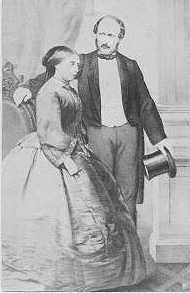
This picture was taken from an exceedingly rare CDV from the late 1850's. It features an art print of a photograph of Queen Victoria, and her husband, Prince Albert. Queen Victoria died on 22nd January 1901 at Osborne House on the Isle of Wight and was buried in The Mausoleum, Frogmore, Windsor, on 4th February 1901 following a State Funeral in St. George's Chapel on 2nd February 1901.
After the funeral her coffin lay-in-state in The Albert Memorial Chapel for two days and was then taken to The Mausoleum by The Royal Horse Artillery. Her son, Edward, had been proclaimed King Edward VII.
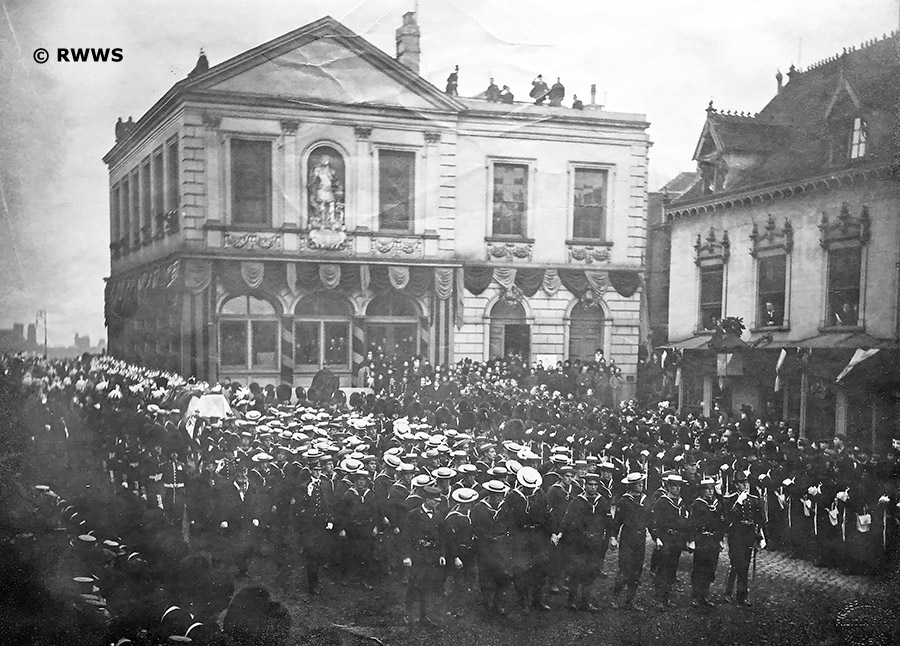
The Funeral Cortège pauses for a moment just past The Guildhall on its way to Park Street, the Long Walk, and up through the castle grounds to St George's Chapel. 2nd February 1901.
As described in the letter below, the Royal Horse Artillery had been unable to draw the gun carriage and so sailors from the Royal Navy has taken over the task within moments.

A stereoview of the Funeral Cortège looking up the High Street and passing the Union Hotel.
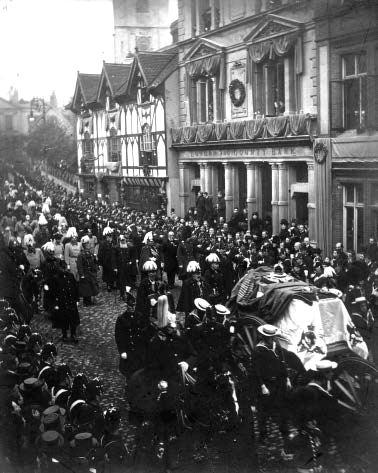
After the funeral service, officers of The Grenadier Guards guarded the body of the late Queen Victoria during the Lying in State in The Albert Memorial Chapel, 2nd - 4th February, 1901.
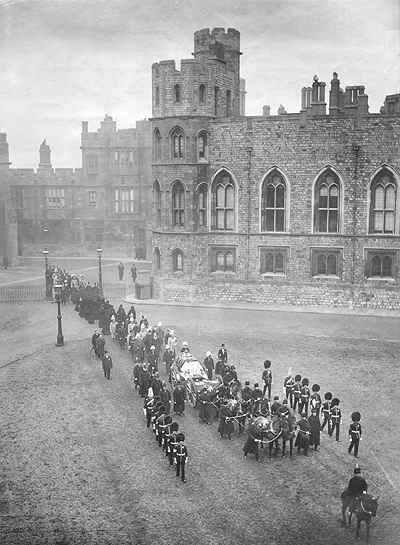
Two days after the funeral, on 4th February 1901, Queen Victoria was taken to Frogmore Mausoleum to rest beside her husband Prince Albert. In this picture the cortège is on its way from The Albert Memorial Chapel through the Upper Ward of Windsor Castle, drawn by the Royal Horse Artillery.
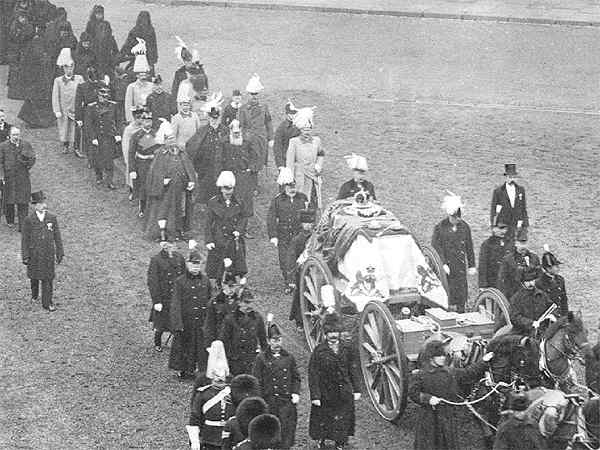
Detail from the photograph above of Queen Victoria's Funeral Cortège. King Edward VII is clearly seen in the centre immediately behind the coffin, with the German Kaiser to his right.
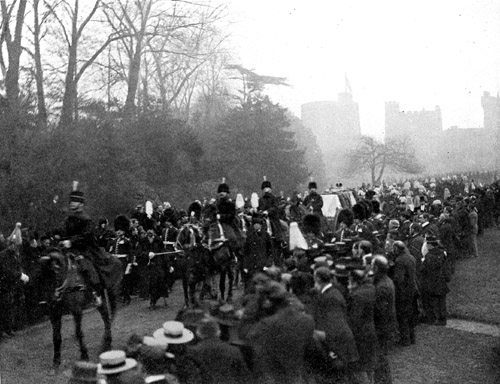
The cortège passes along the Long Walk on its way to Frogmore
Queen Victoria's Funeral
The Gun Carriage Episode
The following letter was published by The Times of 28th January 1936. It relates to the origins of ratings from The Royal Navy hauling on foot the monarch's coffin to the Funeral Service. There has been some uncertainty as to what precisely happened, but this eye-witness letter, from Cecil B. Levita, Officer Commanding, seems to describe events accurately and definitively as the cortege was leaving Windsor Central Station.
To The Editor of The Times
Sir,
In your issue of January 25 [1936] you refer to the historic gun-carriage to be used tomorrow. It is stated:At Queen Victoria's funeral there was an unfortunate contretemps in connection with the horses which were to have been used to draw the coffin up the hill at Windsor, and the blue-jackets [naval ratings] manned the drag ropes in the emergency.
It would, perhaps, be more accurate to say that the contretemps was in connection with the so termed gun-carriage than "with the horses" or their handling by the Royal Horse Artillery.
February 2, 1901, was a bitterly cold day with some snow, and the gun-carriage, under the charge of S Battery, R.H.A., [Royal Horse Artillery] and under the independent command of Lieutenant M. L. Goldie, had been kept waiting at Windsor Station, together with naval and military detachments, etc., for a considerable period. I had posted N/R.H.A. which battery I commanded, in the Long Walk ready to fire a salute of 81 guns, commencing when the cortege left Windsor Station for St. George's Chapel, at about 3 p.m. I placed Lieutenant P. W. Game (now Chief Commissioner of Metropolitan Police) in command, and proceeded to the station to ensure that signalling arrangements were perfect. When the Royal coffin, weighing about 9cwt., had been placed on the carriage, drums began muffled rolls, which reverberated under the station roof, and the cortege started. Actually, when the horses took the weight, the eyelet hole on the splinter bar, to which the off-wheel trace was hooked, broke. The point of the trace struck the wheeler with some violence inside the hock, and naturally the horse plunged. A very short time would have been required to improvise an attachment to the gun-carriage. However, when the wheelers were unhooked the naval detachment promptly and gallantly seized drag ropes and started off with the load. The "gun-carriage" had been specially provided from Woolwich and was fitted with rubber tyres and other gadgets. This was due to Queen Victoria's instructions after seeing a veritable gun-carriage in use at the Duke of Albany's funeral, as also was the prohibition of the use of black horses. On February 4, in compliance with the command of King Edward, I conveyed the royal coffin, on another carriage, from Windsor to the Royal Mausoleum at Frogmore by means of the same detachment of men and horses. I may add that a few days later King Edward told me that no blame for the contretemps attached to the Royal Horse Artillery by reason of the faulty material that had been supplied to them.
I have the honour to be, Sir, your obedient servant,Cecil B. Levita
January 27th 1936With acknowledgements to The Times. This letter was sent by Major Cecil Bingham Levita M.V.O.
November 2006.
Martin Reed has sent us the following:Troop Serjeant Major John Roughan Yeoman of the Guard 9th Lancers was on duty at Queen Victoria's Lying-in-State and also Edward VII's Lying-in-State and George V's Coronation.
ROUGHAN, John. Troop Serjeant Major. 9th Lancers.
Born at Ennis, County Clare in 1844. By occupation a clerk, he enlisted 16 March. 1863. He was made Corporal 16 November, 1863 and was promoted Serjeant on 1 February, 1871 and to Troop Serjeant 11 November 1874. He re-enlisted to complete 21 years service on 16 November, 1874. Roughan sailed for India 9 January, 1875 returning home in 1877 where that year he married Elizabeth May Duffy at Isleworth on 6 October. He was sent back to India and arrived there on 16 December, 1878, then was posted to Afghanistan on 13 March, 1879 where he served in the war of 1878-80. Roughan took part in the march to Kandahar and so earned the Afghan Medal 1878-80 (clasps Kabul, Kandahar) and the Kabul to Kandahar Star.Troop Serjeant Major John Roughan Yeoman of the Guard 9th Lancers
He arrived back in England 5 May, 1882 having earned the LS & GC Medal on 14 December, 1881, and was discharged in March, 1884. He obtained a position with the Royal Parks Department and rose to Inspector, serving for 24 years. On 17 December, 1893 Roughan was sworn in as a Yeoman in Ordinary of Her Majesty's Body Guard of the Yeomen of the Guard, vice Colour Serjeant Everett, Coldstream Guards, later becoming Serjeant Major of the Guard.
On 12 December, 1932, he died at Ashford, Staines, Middlesex, aged 87 years, leaving a widow, and three sons, all three of whom had served in WW 1. According to at least one obituary, amongst his most prized possessions was a signed photograph of Lord Roberts bearing the inscription: 'in remembrance of Afghanistan'. He was equally proud of another photograph of King Edward VII, this having been signed by King George V and presented to him in recognition of his work during the late Monarch's lying in State.
His medals were auctioned at Spink in November, 1998 and were on display at the Orders and Medals Research Society Convention in 2000: Afghan Medal (Kabul, Kandahar), Kabul to Kandahar Star, Jubilee 1897 (bronze privately engraved J. Roughan. Yeoman of H.M.R.B. Guard), Coronation Medals 1902 (bronze) and 1911, LS & GC and Imperial Service Medal (Edward VII) with photographs. The lot was offered again in the March sale. 2002, by Dix, Noonan & Webb, and realised £1,750, (267)
The Queen Victoria Statue, 1887 |
|
Any information or additional material about Windsor is always welcomed and acknowledged.Copies of photographs or texts can be emailed to the Editor, The Royal Windsor Web Site